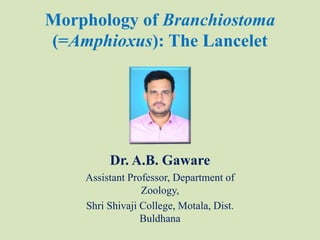
Amphioxus.pptx
- 1. Morphology of Branchiostoma (=Amphioxus): The Lancelet Dr. A.B. Gaware Assistant Professor, Department of Zoology, Shri Shivaji College, Motala, Dist. Buldhana
- 2. Branchiostoma (=Amphioxus): The Lancelet The members of the subphylum Cephalochordata are small, marine and superficially fish-like chordates. They are of special significance because they possess the three distinctive or primary chordate characters such as notochord, dorsal tubular nerve cord and pharyngeal gill slits, in simple condition throughout life. Thus, they display the simple primitive chordate condition and are considered a blueprint of the phylum Chordata. The most extensively studied cephalochordate type, and also the best known example of protochordates is Branchiostoma (= Amphioxus) commonly called as 'lancelet' or 'lancet'. It was first described by the German scientist Pallas in 1778. He considered it to be a slug (phylum Mollusca) and named it Umax lanceolatus. An Italian scientist Costa (1834) first recognized its chordate nature and described it as Branchiostoma lanceolatum. Two years later (1836), Yarrel named it as Amphioxus lanceolatus.
- 3. Systematic Position Phylum : Chordata Group : Acrania Subphylum : Cephalochordata Class: Leptocardii Family : Braachiostomidae Type : Branchiostoma (=Amphioxus) (The Lancelet) Derivation of Names Cephalochordata (Gr., kephale=head + chorde= cord) ; Acrania (Gr., «=absent + kranion = skull); Amphioxus (Gr., amphi= double + oxys = sharp) 'lancet* or 'lancelet' (a little lance) refer to both Geographical Distribution Branchiostoma is a cosmopolitan, reported different ocean of the world. Habit And Habitat :- Branchiostoma is a marine animal commonly found in shallow waters, preferably brackish or salt water, on the sandy coasts. It leads a double mode of life. Mostly it is buried in sand in an upright condition with only the anterior end protruding above the sand.
- 4. External Features:- Shape, Size and colour:- It is small elongated narrow and fish-like animal 5 to 8 cm in length. Body is whitish, somewhat translucent, laterally compressed and pointed at both the ends, hence the common name “lancelet” which means “a little lance”. The streamline body is well-suited for burrowing as well as swimming. The posterior end is more tapering and pointed than the anterior end. Division of body:- A true head is degenerate and absent. The body is divisible only in two regions. The greater anterior region constitutes the trunk and a much shorter postanal posterior region is the tail. The anterior end of trunk projects in front as a pointed snout or rostrum.
- 5. Apertures:- the trunk bears three openings : mouth, atriopore and anus. • Anterior below the rostrum is a tentaculated structure, the oral hood, formed by dorsal and lateral projections of the body. It shall be described later as a part of the digestive system. • Mouth is a very wide anteroventral aperture, bordered by the free margin of oral hood. Atriopore is a small mid-ventral rounded aperture, laying just in front of the ventral fin. The large atrial cavity surrounding the pharynx opens to outside through atriopore. Another small aperture, the anus, lies somewhat asymmetrically to the left of mid-ventral line at the base of caudal fin. The small posterior body region behind the anus is the tail. Fins and folds:- • Branchiostoma bears three longitudinal median or unpaired fins: dorsal, caudal and ventral. • The dorsal fin runs as a low, mid-dorsal fold along the entire length of trunk. Myotomes and gonads:- • On each lateral side of body a series of shaped muscle bands, called myotomes or myomeres can be seen through the transparent body wall. • Between mouth and atriopore, can also be seen on either side below the myotomes, a series of gonads.
- 6. Body wall The body wall includes from outside 1. Skin. The skin or integumert consists of an outer thin epidermis made of a single layer of columnar epithelial cells resting on a basement membrane. It is ciliated in young individuals, but in mature individuals the cilia are lost and a thin layer of non-pigmented, chitin-like cuticle, perforated at places, is secreted externally. The epidermis contains sensory cells but gland cells and pigment cells are absent. Immediately beneath the epidermis is a tough thiri, and compact, fibrous connective tissue layer, called cutis. Underneath cutis is a thick spongy subcutis made of a gelatinous matrix, containing nerve fibres, cells and blood vessels. A few scattered distributed nomadic cells, similar to fibroblasts of vertebrates, secrete both these layers. 2. Musculature: The muscles lying just beneath the skin form the greater part of body wall. The muscles show distinct metameric segmentation and arranged throughout the length of body in a series of characteristic V-shaped muscle blocks or segments, called myotomes or myomeres. 60-62 in numbers. 3. Peritoneum. The muscle layer is lined internally by a thin layer of parietal paritoneum. It is not continuous in the pharyngeal region but restricted to a few patches.
